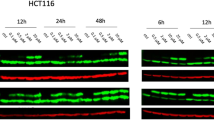Abstract
Purpose: To determine the effect of combined treatment with 7-ethyl-10-hydroxycamptothecin (SN-38, the active metabolite of irinotecan) and 5-fluorouracil/folinic acid (5FU/FA) in vitro using HCT-8 human intestinal adenocarcinoma cells. Methods: Cell survival was examined using colony forming assays. Cell cycle distribution before and after treatment was assessed by flow microfluorimetry. Levels of thymidylate synthase (TS) and topoisomerase I (topo I) in untreated and treated cells were determined by immunoblotting. Changes in deoxynucleotide pools were examined by high-performance liquid chromatography. Results: Clonogenic assays revealed that colony formation was decreased by 50% after a 24-h exposure to 8 ± 2 nM SN-38 or 12 ± 3 μM 5FU, the latter being assayed in the presence of 2 μM FA. When treatment with 5FU/FA was followed by SN-38, the cytotoxicity was similar to that observed with 5FU/FA alone. In contrast, when HCT-8 cells were exposed to both agents simultaneously or to SN-38 followed by 5FU/FA, the cytotoxicity was greater than that of SN-38 or 5FU/FA treatment alone. Investigation of the mechanistic basis for this sequence dependence revealed that SN-38 treatment was associated with a dose- and time-dependent decrease in conversion of [5-3H]-2′-deoxyuridine to [3H]-H2O and thymidylate in intact cells. Immunoblotting failed to reveal any decrease in TS protein that could account for the decreased activity. High-performance liquid chromatography revealed that SN-38 treatment was associated with increased levels of the deoxynucleotide dTTP and decreased levels of dUTP. Flow microfluorimetry revealed that a 24-h treatment with 10 nM SN-38 resulted in accumulation of HCT-8 cells in late S and G2 phases of the cell cycle, with a further increase in the G2 fraction during the 24 h after SN-38 removal. Conclusions: These observations are consistent with a model in which SN-38 sequentially induces diminished DNA synthesis, elevated dTTP pools, inhibition of dUMP synthesis and enhanced toxicity of 5FU/FA. Accordingly, sequencing of irinotecan and 5FU/FA might be important in combining these agents into an effective treatment for colorectal cancer.
Similar content being viewed by others
Author information
Authors and Affiliations
Additional information
Received: 2 September 1997 / Accepted: 16 January 1998
Rights and permissions
About this article
Cite this article
Mullany, S., Svingen, P., Kaufmann, S. et al. Effect of adding the topoisomerase I poison 7-ethyl-10-hydroxycamptothecin (SN-38) to 5-fluorouracil and folinic acid in HCT-8 cells: elevated dTTP pools and enhanced cytotoxicity. Cancer Chemother Pharmacol 42, 391–399 (1998). https://doi.org/10.1007/s002800050835
Issue Date:
DOI: https://doi.org/10.1007/s002800050835




